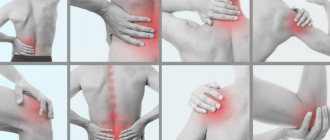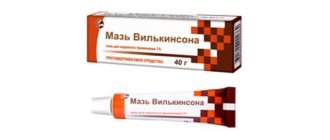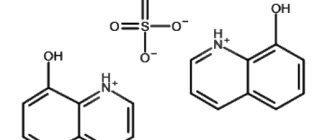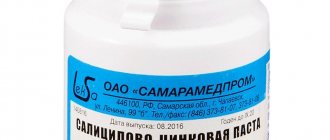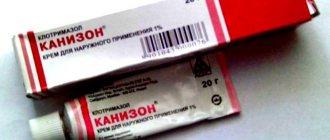Price from 83 rub.
Antiseptic drug.
Application : psoriasis, herpes, bedsores.
Analogues - Aldara, Viru-Merz serol, Furasol. You can find out more about analogues, their prices, and whether they are substitutes at the end of this article.
Today we’ll talk about Biopin ointment. What is this product and how does it affect the body? What are the indications and contraindications? How and in what doses is it used? What can be replaced?
What kind of ointment
The product is necessary to disinfect the resulting skin lesion.
Plays the role of a strong antiseptic that prevents the development of both bacteriological and viral infections.
The effect occurs quickly, without harming the skin, the substance acts gently and slightly moisturizes the epithelium.
The drug also has an anti-inflammatory effect, but cannot fight the cause of various rashes.
Side effects
According to patient reviews, Biopin is well tolerated. However, if you are individually sensitive to a component of the product, side effects may occur after use:
Patients may feel a burning sensation in the areas where the ointment is applied, rashes and hyperemia may appear. However, as a rule, these manifestations pass quickly, without requiring additional use of allergy medications. Therefore, you should not stop the course of treatment. If you experience severe discomfort from using the ointment, you should visit a doctor for consultation.
Active ingredient and composition
The main active ingredient, which has a natural base, is the resin of relict pine trees.
It has been used in medicine since ancient times due to its great effectiveness and lack of toxicity to the human body.
Models biopin 20% and biopin 5% differ in concentration; a larger one is necessary in case of extensive damage, or deeper and more serious ones.
The composition contains some chemical and natural elements, such as:
- pork fat;
- medical Vaseline;
- purified water;
- refined olive oil;
- wax;
- pine resin.
The medicine, indeed, can be called natural for the reason that the vast majority of components are obtained from nature.
Dosage regimen
Biopin 5%
Before using the ointment, the wound derivative should be mechanically removed, followed by washing the wound surface, after which sterile gauze pads with ointment are applied. The dressings are changed daily or every other day, depending on the degree of soaking of the napkins with wound discharge.
The dose of the drug depends on the size of the wound surface and is 2-5 g per wound with an area of 5x5 cm. For large wounds and good tolerance, it is possible to use large quantities of ointment, but not more than 100 g.
After removing the bandage, a small amount of wax remains on the skin around the wound, which is a kind of protective barrier for healthy areas of the skin from the damaging effects of wound discharge, which is especially important in the treatment of intestinal fistulas, extensive trophic ulcers and post-traumatic wounds.
Treatment should be continued until signs of inflammation disappear permanently.
Biopin 10%
Before using the ointment, the wound derivative should be mechanically removed, followed by washing the wound surface, after which sterile gauze pads with ointment are applied. The dressings are changed after 1-2 days (so as not to injure granulation tissue and epithelial cells).
For dermatoses
ointment is used as part of complex therapy. The ointment is applied in a thin layer to the affected areas of the skin for 2-3 days. after treating the skin with an antiseptic.
For herpes
after treatment with acyclovir, the ointment is applied in a thin layer for 3-4 days.
For psoriasis
ointment is used for 2 days. as part of complex therapy. The ointment is not used for progressive exudative process.
For the prevention and treatment of mycosis of the feet and hands
in order to accelerate healing in the nail bed area after onychoectomy, resolve swelling and restore microcirculation in the tissues, in addition to antifungal therapy, ointment on sterile gauze wipes is prescribed.
The dose of the drug depends on the size of the wound surface and is 2-5 g per wound with an area of 5x5 cm. For large wounds and good tolerance, it is possible to use large quantities of ointment, but not more than 100 g.
After removing the bandage, a small amount of wax remains on the skin around the wound, which is a kind of protective barrier for healthy areas of the skin from the damaging effects of wound discharge.
Treatment should be continued until signs of inflammation disappear permanently.
Biopin 20%
For the treatment of inflammatory and post-traumatic diseases of the musculoskeletal system and peripheral nervous system
The ointment is applied in a thin layer (about 1 cm) onto a thick cotton cloth, which is applied to the affected area overnight.
In the treatment of osteochondrosis, myositis, neuralgia
The ointment is rubbed along the spine and painful muscles.
The course of treatment is 7-14 procedures. In case of severe osteochondrosis,
traditional treatment methods are additionally used.
In the treatment of psoriatic arthritis
ointment is applied for 2 days. for 6-7 days using bandages.
The consumption of the drug is 2-5 g. If the surfaces are large and the drug is well tolerated, it is possible to use a larger amount of the drug.
Treatment should be continued until a lasting therapeutic effect is obtained.
Pharmacological properties
The main purpose of the ointment is local application, which has several beneficial functions:
1Wound healing activity is accelerated due to the absence of purulent lesions.
2It has an antiseptic effect, significantly increasing the protection of the immune system.
3Dead horny particles are removed naturally through the action of certain components of the medicine.
4An additional effect is anti-inflammatory, quite pronounced and achieved in the shortest possible time.
5 During a medical study, quite strong activity was observed against some fungal strains, however, in the presence of such a disease, biopin 10% is practically not prescribed.
Pharmacodynamics and pharmacokinetics
The substance is completely natural and penetrates deep into the skin quite quickly.
It affects fats (lipids), oxidizing them and significantly increasing the concentration of phagocytes in the area of damage.
The antioxidant system is activated, which increases the activity of neutrophil leukocytes.
This eliminates the so-called tumor necrosis factor (TNF), but the drug is not used for malignant neoplasms.
Absorption into the bloodstream has not been fully studied.
There is a lack of toxicity, which makes it possible to significantly increase the period of use of the drug, which cannot be said about biopin analogues.
Consumer Reviews
Almost all the reviews left by patients who have ever used the ointment mentioned are positive. They claim that this drug quickly eliminates skin rashes, restoring its integrity and elasticity.
Consumers note that such a medication should be stored in every first aid kit. After all, no person is immune from household wounds, injuries and burns, as well as diseases of the musculoskeletal system.
This drug causes side effects extremely rarely.
Indications
There are many reasons for the indications for the use of this medication. Doctors identify most of them:
- bedsores;
- cracks in the heels or toes;
- weeping, constantly inflamed wounds;
- complex therapy for transmission of the herpes virus;
- phlebeurysm;
- large area of pustular rashes;
- dermatomycosis;
- acne;
- carbuncles;
- psoriasis or seborrhea.
The fight against the points described above takes about two weeks.
A potent version of the drug with a concentration of active substance of 20% can help combat:
- arthritis;
- pain in muscles and joints;
- myositis;
- spondylitis;
- ligament injuries, accelerates the process of their recovery;
- closed fractures after applying plaster;
- osteochondrosis;
- osteoarthritis;
- injuries and bruises resulting from mechanical damage during sports or other activities.
Biopin: instructions for use of ointment
Indications for use
Biopin 5, indications:
- Intestinal fistula
- Burn of any degree of damage
- Herpetic wound in the initial stage
- Trophic ulcer without increased exudation
- Keratoderma
- Bedsores without strong discharge
- Cracks in the skin of the feet, palms and heels
- Injuries after significant damage that do not heal well
- Eczema
- Ichthyosis
- Atopic dermatitis.
Biopin 10 is intended for use in the presence of:
- Neurodermatitis
- Trophic ulcers, wounds after surgery, granular bedsores
- Dermatomycosis
- Processes of suppuration followed by inflammation in the subcutaneous fat and skin at the infiltration stage
- Seborrhea
- Allergic dermatitis
- Herpes
- Psoriasis
- Acne.
Biopin 20 is prescribed for:
- Various joint damage, muscle, ligament and tendon injuries
- Osteoarthrosis
- Psoriatic arthritis
- Spondylitis
- Tunnel neuropathy
- Neuralgia
- Myositis and myopathies
- Arthritis or arthrosis
- Polyarthritis
- Arthralgia.
Composition and release forms
Biopin Pharma consists of 50 mg, 100 mg or 200 mg of active ingredient per 1000 mg of ointment. Additionally, the composition includes: deodorized olive oil, cattle fat and natural wax.
Biopin 5, 10 or 20 ointment is available in plastic tubes of 30, 50 or 100 grams. The product has a yellow tint and is homogeneous.
Medicinal properties
Biopin has pronounced anti-inflammatory and analgesic properties.
The medicine is a medicine of natural origin, the components of which have antiseptic, anti-inflammatory, wound-healing and analgesic effects.
Pine resin has antibacterial properties against streptococci, staphylococci, pseudomonas and escheria, as well as fungi.
The active substance in the ointment stimulates redox processes in the body and actively prevents the formation of free radicals. Inhibition of lipid breakdown products also occurs. In the affected area, the phagocytic index is stimulated. In general, the activity of neutrophil leukocytes and the synthesis of TNF are increased in the body.
Mode of application
Biopin Pharma 5 mg – apply a thin layer to the wound and cover with sterile gauze bandages. If the wounds are extensive, then you can apply a thick layer, but not more than 100 grams per day. The dressings need to be changed every other day.
Biopin 10 mg for herpes, dermatosis and psoriasis is applied 2-3 times a day in a thin layer to the affected skin areas. There is no need to put a bandage on top. If you have a fungal infection of the foot, you need to apply sterile bandages with ointment so that the foot heals faster.
Biopin 20 mg for neuralgia, muscle and joint diseases - rub a thin layer over the affected area once a day. The course of treatment is 2 weeks. For psoriatic arthritis, ointment and bandages should be applied twice a day for a week.
Contraindications
Despite its wide range of uses, the medicine has only two absolute contraindications:
1Individual intolerance (allergic reaction) to at least one of the components, even if it is observed in low concentrations or is a binder.
2Hypersensitivity. You can check this point when it comes to ointments at home. To do this, a small amount of content is rubbed into a sensitive area (armpits, back of the hand). If there is no pronounced pain within 15-20 minutes, then everything is fine.
Biopin
Biopin is an antiseptic drug that has anti-inflammatory and antimicrobial effects and improves tissue regeneration.
Release form and composition
Biopin is available in the form of an ointment for external use from light yellow to dark yellow in color, with a slight odor of beeswax and pine resin. The ointment is available in 30, 40 or 50 g in polypropylene jars, dark glass jars or aluminum tubes. One cardboard box contains 1 jar or tube.
The active ingredient in the drug is pine resin. 1 g of ointment 5% contains 50 mg, ointment 10% – 100 mg, ointment 20% – 200 mg of active ingredient.
The excipients in Biopin are the following components:
- Rendered edible pork fat;
- Beeswax;
- Refined olive oil.
Indications for use
According to the instructions, Biopin 5% is used for the following pathologies:
- Atopic dermatitis;
- Keratoderma;
- Eczema;
- Clean and infected burns of all degrees;
- Bedsores with a small amount of wound discharge;
- Trophic ulcers with moderate exudation;
- Cracks in the palms and soles;
- Ichthyosis;
- Long-term non-healing post-traumatic wounds without purulent processes;
- Herpes in the initial erythematous stage.
According to the instructions, Biopin 10% is used to treat the following pathologies:
- Allergic dermatitis;
- Limited neurodermatitis;
- Herpes;
- Dermatomycoses;
- Psoriasis;
- Acne;
- Seborrhea;
- Purulent-inflammatory skin diseases and diseases of subcutaneous tissue in the infiltration stage;
- Post-traumatic and postoperative wounds in the granulation stage.
The use of Biopin 20% is effective in the treatment of inflammatory diseases of the joints and soft tissues, diseases of the peripheral nervous system, which are characterized by pain and limited microcirculation disorders, as well as traumatic injuries of the musculoskeletal system. The drug is used in the presence of the following diseases:
- Osteochondrosis with neurological manifestations;
- Tunnel neuropathy;
- Neuralgia;
- Osteoarthritis;
- Arthrosis;
- Arthritis;
- Spondylitis;
- Myalgia;
- Myositis;
- Arthralgia;
- Polyarthritis;
- Psoriatic arthritis.
Directions for use and dosage
Before using Biopin 5% and 10%, it is necessary to remove the wound derivative and wash the wound surface. After this, apply a sterile gauze pad with ointment.
The dressings must be changed daily or every other day.
The dose depends on the size of the wound surface and is usually 2-5 g of ointment. In cases of good intolerance and extensive wounds, larger quantities may be used. However, a single dose of the drug should not exceed 100 g.
In the treatment of psoriasis and dermatoses, Biopin 10% is used as part of complex therapy. The ointment is applied in a thin layer to the affected areas 2-3 times a day.
For herpes, the drug should be applied 3-4 times a day.
For the treatment of myositis, osteochondrosis and neuralgia, Biopin 20% is applied daily to painful muscles and along the spine, then rubbed. The course of therapy is 1-2 weeks.
In the treatment of post-traumatic and inflammatory diseases of the musculoskeletal system and peripheral nervous system, the drug is applied to cotton cloth, which is applied to the affected areas overnight.
Therapy with the drug should be continued until a lasting therapeutic effect is obtained.
Side effects
The use of Biopin in some cases may cause side effects in the form of local reactions (burning, redness, itching).
Terms and conditions of storage
Biopin should be stored in a dark and dry place, out of reach of children, at a temperature of 10-25 °C.
The shelf life is 2 years.
Source: https://medlib.net/biopin.html
Directions for use and dosage
The main method of application is a gauze bandage, but before the procedure it is necessary to remove the remaining pus, the stratum corneum (which can be removed) and thoroughly rinse the wound. The device should be changed once a day.
An important feature is that after a certain period of time, a small wax ball will be noticed on the skin, which separates living cells from dead ones.
You shouldn’t remove it yourself; just treat the skin around it with an antiseptic and after a while it will fall off on its own.
For dermatosis and herpes virus, it is enough to apply the substance in a thin layer until completely absorbed. It is recommended to repeat the procedure 3-4 times a day.
Effect of the drug and indications for use
The ointment has a pronounced antiseptic effect . It has anti-inflammatory, antimicrobial, analgesic and wound-healing effects.
- The drug is effective against fungi, gram-positive and gram-negative bacteria.
- Biopin 5 influences oxidative and reduction processes, normalizes the functioning of the antioxidant system, and increases the phagocytic index.
- With Biopin 5 you can treat:
- trophic ulcers;
- burns;
- post-traumatic wounds that do not heal for a long time (non-purulent);
- bedsores;
- eczema;
- atopic dermatitis;
- ichthyosis;
- cracks;
- keratoderma;
- initial stage of herpes infection;
- intestinal fistulas.
With Biopin 10 you can treat:
purulent, inflammatory diseases;
- postoperative or post-traumatic wounds;
- allergic dermatitis;
- seborrhea;
- psoriasis;
- herpes;
- acne;
- limited neurodermatitis;
- dermatotoxicosis.
Thanks to Biopin 20 you can get rid of:
- myalgia;
- osteochondrosis;
- neuralgia;
- arthrosis;
- tunnel neuropathy;
- myositis;
- osteoarthritis;
- osteoporosis;
- arthritis;
- arthralgia;
- polyarthritis;
- spondylitis.
Application (instructions)
Before applying the ointment, it is necessary to wash the affected area. Then take a sterile gauze pad, apply Biopin 5 on it and apply it to the affected area. The napkin needs to be changed. How often? This depends on the degree of wound fluid secretion, but not more often than every day.
The dosage of the ointment is related to the size of the affected surface. On average, it is necessary to apply 2 - 5 g of ointment. This dosage is suitable for a wound measuring 5x5. This applies to the use of Biopin 5. Extensive damage will require a larger amount of the product, up to 100 g. Biopin is used until the inflammatory symptoms disappear.
Biopin 10 is used as follows: for herpes infection, after treatment with special ointments, the drug must be applied in a thin layer directly to the rash. Up to 4 times per day.
When treating dermatosis, apply to the affected areas treated with an antiseptic up to 3 times a day.
To treat psoriasis, the ointment is used twice a day. When treating a fungus, after removing the damaged nail plate, the ointment is first applied to a sterile napkin and then applied to the affected area.
When treating joints and the peripheral nervous system, Biopin 20 must be applied to the tissue in a layer of no more than 1 cm and applied to the affected area. Leave overnight.
When treating psoriatic arthritis, a bandage with Biopin is applied twice daily for 7 days.
Contraindications and adverse reactions
There are not too many of them, but you need to know about them.
Contraindications to the use of ointment are as follows:
Hypersensitivity to ointment components.
- Allergic generalized reactions.
- Hyperhormonal conditions.
Under the last two points, the drug can be used, but with some caution.
An allergic reaction may occur in the form of burning, itching, and redness. If its manifestation is severe, the use of the drug should be discontinued. The affected area must be blotted with ethyl alcohol 40% or washed with soapy, warm water.
Analogs
The list of analogues includes the following drugs:
- Ebermin;
- Allizarin;
- Abisib;
- Acigerpin;
- Virolex;
- Oflocaine;
- Zovirax Duo;
- Furasol;
- Aldara;
- Acyclovir;
- Herpeferon;
- Rosamet;
- Kondilin;
- Metrogil.
Biopin: reviews
People who have used Biopin 5 leave positive reviews . They report that the drug quickly relieves skin rashes and increases skin elasticity and integrity. And adverse reactions from using the ointment occur extremely rarely. People note the effectiveness of the drug on small wounds, cracks, and abrasions. It is also noted that the ointment helps in the treatment of postoperative sutures that do not heal for a long time.
Although you can also find negative reviews that report the occurrence of an allergic reaction.
I have been using Biopin 5 for a long time. I use it to treat my grandmother’s and mother’s bedsores. It took about 5 days to see the result.
Sophia
Biopin 5 helps me with joint pain. As soon as I apply it, the unpleasant sensations miraculously disappear.
Diana
Source: https://lekarstva.guru/b/instruktsiya-k-primeneniyu-mazi-biopin.html
Analogs
Analogs by ATX code: no.
Medicines with a similar mechanism of action (matching level 4 ATC code): Gum Ointment, Pine Resin.
Do not decide to change the drug on your own; consult your doctor.
Aldara
Laboratories Kazen Fleet, Spain
The average cost in Russia is 4,685 rubles per package.
Aldara is prescribed for the treatment of condylomas, papillomas, basal cell carcinomas and keratosis. Release form: cream in sachets. The active ingredient is imiquimod.
Pros:
- Efficiency
- Powerful immunomodulator.
Minuses:
- Price
- Side effects.
Darnitsa, Ukraine
The average cost of the drug in Russia is 125 rubles per package.
Oflocain is a combined ointment based on the antibiotic ofloxacin and the local anesthetic lidocaine. The product is used to treat wounds that do not heal for a long time, with purulent and inflammatory processes on the skin, bedsores and abscesses. Sold in aluminum tubes of 15 or 30 grams.
Pros:
- Efficiency
- Good value.
Minuses:
- Cannot be prescribed to pregnant women
- Resistance may develop.

